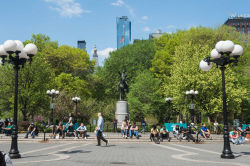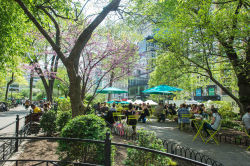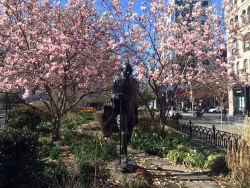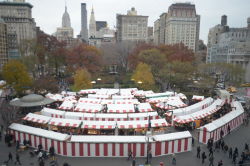Union Square Park
July 4th Marks 150th Anniversary of the Dedication Of Union Square’s George Washington Monument
Monday, July 3, 2006
No. 54
http://www.nyc.gov/parks
On July 4, 2006 we celebrate the sesquicentennial of the oldest existing sculpture in a New York City park- the equestrian sculpture of George Washington, located on Union Square Park’s southern plaza. Dedicated on July 4, 1856, the monument was modeled by Henry Kirke Brown at his Brooklyn studio, with assistance from John Quincy Adams Ward, and cast at the Ames Foundry at Chicopee, Massachusetts. It was only the second equestrian statue cast in the United States. Brown chose to depict Washington at the moment of British evacuation during the Revolutionary War, and chose to combine a classical pose evoking the ancient Roman Marcus Aurelius sculpture with naturalistic features of both the horse and rider. The sculpture is of bronze, and sits on an elaborate pedestal of Quincy granite. The George Washington monument set a precedent in the City, paving the way for numerous public artworks, often commemorative, which have originated through citizen action and been commissioned through private contributions. Sixty-eight major donors, mostly prominent merchants in the vicinity of Union Square each contributed $500, and 45 lesser donors gave amounts between $20 and $300, for the creation and installation of the George Washington monument. The sculpture was conserved in 1988 through the Adopt-A-Monument Program, and was again conserved in 2004 by Parks’ Citywide Monuments Conservation Program--a privately-financed initiative, now in its tenth year, that seeks to preserve and maintain the art and monuments throughout the parks system. This year the program’s major supporters are the History Channel and the Samuel H. Kress Foundation. A separate endowment provides dedicated support for the care of the George Washington sculpture. Today, July 3, a commemorative wreath was placed on the head of the George Washington monument during a celebration to recognize this sesquicentennial anniversary of New York’s oldest public artwork. - 30 -
Check out your park's Vital Signs
Clean & Safe
Green & Resilient
Empowered & Engaged Users
Share your feedback or learn more about how this park is part of a
Vital Park System




